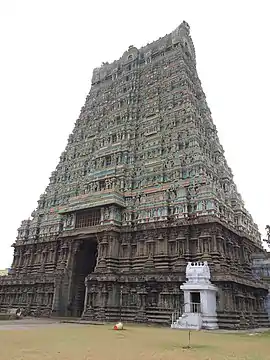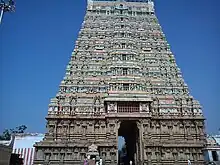Tenkasi Pandyas | |||||||||||||
|---|---|---|---|---|---|---|---|---|---|---|---|---|---|
| 1422 C.E.–1618 C.E. | |||||||||||||
 A close depiction of Tenkasi Pandiya flag as per archaeological findings and historians illustration.[1] | |||||||||||||
Location of the present day Tenkasi (Capital of Tenkasi Pandyas) and Madurai (Pandya dynasty's traditional capital) | |||||||||||||
| Capital | Tenkasi | ||||||||||||
| Official languages | Tamil[2][3] | ||||||||||||
| Religion | |||||||||||||
| Government | Monarchy | ||||||||||||
• 1422–1463 CE | Sadaavarman Parakrama | ||||||||||||
• 1613–1618 CE | Varagunarama | ||||||||||||
| Historical era | Early modern era | ||||||||||||
• Established | 1422 C.E. | ||||||||||||
• Disestablished | 1618 C.E. | ||||||||||||
| |||||||||||||
| Today part of | Tamil Nadu, India | ||||||||||||
Tenkasi Pandyas were the Pandya kings from Sadaavarman Parakrama Pandya to his successors who ruled with Tenkasi as their capital.[4] With the invasion of the Sultanates, Vijayanagaras, and Nayakars from the fourteenth century onwards, the Pandyas lost their traditional capital of Madurai and shifted to cities like Tenkasi and Tirunelveli.[5] Tenkasi was the last capital of the Pandyas.[6] All the Pandyas from Sadaavarman Parakrama Pandya and his next generations were crowned in the Adheenam Mutt[7] in Kasi Viswanathar temple.[8] During the same period, some Pandyas ruled with Tirunelveli as their capital. Kayatharu, Vadakkuvalliyur, and Ukkirankottai are some of their major cities. Inscriptions on them are found in Tenkasi's Kasi Viswanathar temple, Brahmadesam, Cheranmadevi, Ambasamudram, Kalakkad and Pudukkottai. The last Pandyan king to be known in the history of the Pandyas was Kolakonda, who was also among the Tenkasi Pandyas.


| Part of a series on |
| Dravidian culture and history |
|---|
 |
| Portal:Dravidian civilizations |
All the Pandyas of the Varagunarama Pandya period were under the Vijayanagara Empire and paid them tribute.[9] However, other sources invariably mention that though the Madurai Nayakas were in-charge of Madurai, from time to time, they were opposed by and had skirmishes with the Tenkasi Pandyans, who are also said to have had intermittent control of Madurai. The Tenkasi Pandyas also had imperial ambitions, fought some wars, conquered territories outside their terrain. This is proven by the fact that the last Tenkasi Pandyan king bore the title "Kollamkondan", which means the one who conquered Kollam in Malayalam country.[10]
Pandyas losing Madurai
Although the Vijayanagara Empire and the Nayaks ruled Madurai after the 14th century, they were occasionally opposed by the Pandyas. Sometimes they have ruled Madurai. Prominent among them were Saadavarman Vikrama Pandya (1401 – 1422 AD) and his son, Arikesari Parakrama Pandya.[11] They had built 32 forts around Madurai. Later, when Vishwanatha Nayakkar became the Madurai Mandalasuvaran, he feared of Pandya resurgence in Madurai. He divided Madurai into 72 districts, including 16 districts of those closest to the Pandyas.[12] He gave them positions and made them separate from the Pandyas. This made Pandyas to lose Madurai forever.[11]
Tenkasi's origin

Shenbagapozhil in Tamil means "champak tree-lined rainforest". In the fifteenth century, Lord Shiva is said to have had appeared in the dream of King Parakrama Pandya, who ruled the Shenbagapozhil area. In that dream, he was said that a lingam worshiped by the Pandya's ancestors was in the Shenbaga forest. He was said that ants could be found crawling out of their fort and if they followed the ants, the lingam could be found. He was also told by Shiva to construct a temple there. The reason is the order from Shiva, "Shiva devotees in the south die before reaching Kashi on their way to Varanasi in the north. So for them to get my grace, build a city equaling that of Varanasi in the south". Obeying his words, King Parakrama Pandya built the Tenkasi gopuram for his ancestor-worshiped lingam. The word Tenkasi translates to "South Kashi" ("ten" or "then" meaning south in Tamil). The town was called the Tenkasi after the temple.[13]
Other names
Tenkasi was known by 16 names before the reign of Sadaavarman Parakrama Pandya.[13] They were
- Sachhithanapuram
- Muttuthantavanallur
- Anantakkuthanur
- Saivamuthur
- Tenpuliyur
- Kuyinkudi
- Sittharvasam
- Senpagapozhil
- Sivamavoor
- Sathamaatharoor
- Sithiramoolathanam
- Mayilaikudi
- Palalinkapaadi
- Vasanthakudi
- Kosigai
- Sitharpuri
Cityscape
The Pandya city of Tenkasi was centered around the Kasi Viswanathar temple. There were square-shaped streets in succession around the temple. The Tenkasi Pandyas were based on a fortress known as Ukkirankottai.[14]
List of Tenkasi Pandya kings


| Part of a series on |
| Dravidian culture and history |
|---|
 |
| Portal:Dravidian civilizations |
| Part of a series on |
| History of Tamil Nadu |
|---|
 |
List of Pandyas who ruled with Tenkasi as the capital.
| No | King | Period |
|---|---|---|
| 1 | Sadaavarman Parakrama Pandya | 1422–1463 AD |
| 2 | Kulasekara Pandiyan III | 1429–1473 AD |
| 3 | Aksharan Perumal Parakrama Pandya | 1473–1506 AD |
| 4 | Kulasekara Pandya | 1479–1499 AD |
| 5 | Sadaverman Sewallapa Pandya | 1534–1543 AD |
| 6 | Parakrama Kulasekaran | 1543–1552 AD |
| 7. | Nelveli Maran | 1552–1564 AD |
| 8. | Sadaavarman Adeevirama Pandya | 1564–1604 AD |
| 9. | Varathuranga Pandya | 1588–1612 AD |
| 10. | Varagunarama Pandya | 1613–1618 AD |
| 11. | Kollankondan (Pandya Dynasty) | (N.A.) |
Proofs
Historic text
Pandya Kulodayam is a Pandya history book written by Mandalakavi (zonal poet) of the Tenkasi Pandya period.[15] The information it contained were:
- The first Pandya king to be crowned with Tenkasi as the capital was the Sadaavarman Parakrama Pandya.
- All the Pandya kings after him were crowned in the Tenkasi temple. They were inscribed in the temple's inscriptions.
- The last Pandya king, King Kolakkondan, was killed in approximately AD 1615.
Numismatics
Although the Pandya kings who ruled Tenkasi ruled only marginal lands, they had issued coins in their name. The coins with the name of King Sadayarvarman Kulasekara Pandya II's son Aagavarman, were found.
Art
 Kasi Vishwanathar temple's Rajagopuram (Main gateway)
Kasi Vishwanathar temple's Rajagopuram (Main gateway) Another view of the Rajagopuram
Another view of the Rajagopuram Thirukutralam temple
Thirukutralam temple
Notable temples
| No. | Temple | Note |
|---|---|---|
| 1 | Kasi Viswanathar temple | The origin period is unknown. Temple towers and shrines were erected during the reign of Saadavarman Parakrama Pandya. |
| 2 | Thirukutralam temple | The origin period is unknown. Temple towers and shrines were erected during the reign of Saadavarman Parakrama Pandya. |
| 3 | Kulasekaranath Temple | Built during the reign of Saadavarman Ativirama Pandya. |
Temple's specialty
Vayuvasal (Sadaavarman Parakrama Pandya entrance)
- The temple's gopuram is known as Vayuvasal (Gateway of the air). The breeze from Vaigai river comes through this gateway. This makes it difficult to enter in the Tamil month of Ādi. Outside of the Bala Subramainya temple, there are musical pillars.
Single-stone statues
Some of the sculptural masterpieces of Tamil Nadu can be seen in the Thiruoolaka Mandapam at the Swami sannathi. There are 16 statues in the hall.
- Agni Veerapathirar
- Rathidevi
- Maha Thandavam
- Urthuva Thandavam
- Kalidevi
- Mahavishnu
- Manmathan
- Veerapathirar
- Paavai
- Paavai
- Tharman
- Beeman
- Arjunan
- Nakulan
- Sahadevan
- Karnan
The above statues are all sculpted out of single stone with subtle workmanship by the Pandya-era sculptors.
Tunnels
The entrance to the tunnel is still visible in the big temple. It is said to have four tunnels.
- The Avur people still say that the tunnel to the east is going to Vindhankottai in Sundarapandiapuram.[16]
- Another route is said to pass through the Kulasekara Nathar Temple.
Thirumalapuram Paintings
There is a cave temple on the Thirumalapuram hill near Tenkasi. It is on the way to Serndamaram village near Kadayanallur. The temple has paintings of the Pandya period. The first to discover these paintings was scholar Duprai. These colour cave temple paintings exemplify the art of the Pandya period.
Literature
Tenkasi Pandyas had also contributed to Tamil literature.[17]
| Year | Capital | Pandya king | Texts | Guru (Master) |
|---|---|---|---|---|
| 1560 –1600 | Karuvai, later Tenkasi | Varakunaraman | Vaayu Sangeethai, Ilinga Puranam | Akora Shivam Swami Devar (also known as Kulasekara Pandya) |
| 1588 – 1613(?) | Karuvai | Varathurangaraman | Pramothira Kaandam, Karuvai Anthathi, Kokogam | Vembathur Eesana Munivar |
| 1564 – 1610 | Tenkasi | Ativiraraman known as Seevalaraman | Naidatham, Kashi Kandam, Koorma Puranam, Vetriverkai | Swamidevar |
Apart from these, a historical book called Pandya Kulodayam was also written by Mandalakavi during the Tenkasi Pandyas period.
References
- ↑ Walter Codrington, Hubert (1975). Ceylon Coins and Currency. Asian Educational Services. ISBN 9788120609136.
- ↑ Upinder Singh (2008). A History of Ancient and Early Medieval India: From the Stone Age to the 12th Century. Pearson Education India. p. 46. ISBN 978-81-317-1120-0.
Kings of the Chola and Pandya dynasties also issued Tamil and bilingual Sanskrit–Tamil inscriptions.
- ↑ C. Sivaramamurti (1977). L'Art en Inde. H. N. Abrams. p. 60. ISBN 978-0-8109-0630-3.
Thus the state language was Tamil whether the inscriptions were from the north or the south and whether the dynasty was Gupta, Vakatak[a], Vardhana, Maukhari, Pratihara, Paramara, Chandella, Pala, Sena, Gahadavala, Haihaya, Ganga, Pallava, Chola, Pandya, Chalukya, Rashtrakuta, or Vijayanagar[a]. Inscriptions were sometimes written in regional languages, but they invariably had a preface in Sanskrit.
- ↑ "4.5 பிற்காலப் பாண்டியர் (கி.பி. 1371 - 1650)". தமிழ் இணையப் பல்கலைக்கழகம். Retrieved 27 November 2012.
- ↑ Karashima, Noburu. 2014. 'The Fall of the Old States', in A Concise History of South India: Issues and Interpretations, ed. Noburu Karashima, pp. 173–74. New Delhi: Oxford University Press.
- ↑ ":: TVU ::". www.tamilvu.org. Retrieved 9 April 2020.
- ↑ Vanamamalai, N.; Vān̲amāmalai, Nā (1981). Interpretation of Tamil Folk Creations. Dravidian Linguistics Association. Archived from the original on 10 March 2016. Retrieved 10 April 2020.
- ↑ "தென்காசி காசிவிசுவநாதசுவாமி கோயில் வரலாறு கோயில் வெளியீடு". 1964.
{{cite journal}}: Cite journal requires|journal=(help) - ↑ Sathianathaier, R.; Aiyar, R. Sathyanatha (1991). History of the Nayaks of Madura. Asian Educational Services. ISBN 978-81-206-0532-9. Archived from the original on 10 March 2016. Retrieved 10 April 2020.
- ↑ "தென்காசிப் பாண்டியர்கள் !". dhinasari.com. 30 November 2019. Retrieved 1 August 2020.
- 1 2 Sathayanatha Iyer (1924). History of the Nayaks of Madura. p. 58.
- ↑ தமிழ்வாணன் (1983). கட்டபொம்மன் கொள்ளைக்காரன். சென்னை: மணிமேகலை பிரசுரம். pp. 18–19.
- 1 2 தென்காசி தல புராணம்
- ↑ தென்னாட்டுப் போர்க்களங்கள், கா. அப்பாத்துரை
- ↑ "4.5 பிற்காலப் பாண்டியர் (கி.பி. 1371 - 1650)". தமிழ் இணையப் பல்கலைக்கழகம். Retrieved 27 November 2012.
- ↑ "விந்தன் கோட்டை". Natpu (in Tamil). 29 June 2011. Archived from the original on 16 January 2013.
- ↑ "தென்காசிப் பாண்டியர்கள் !". Dinasari. 30 November 2019. Retrieved 10 April 2020.

